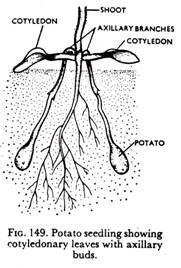The following six points will highlight the six kinds of leaves.
They are: (1) Cotyledonary Leaf (2) Cataphylls or Scale Leaves (3) Hypsophylls or Bract Leaves (4) Prophylls (5) Floral Leaves and Sporophylls and (6) Foliage Leaves.
Kind # 1. Cotyledonary Leaf:
The first leaves on the shoot are represented by the cotyledons. The node on the tigellum where the cotyledons are attached in a dicotyledonous seed represents the first node of the shoot. The cotyledons may bear buds in their axils as in potato . In pea or bean the cotyledons are fleshy because of the storage of food material while in castor it is thin with vein markings. After germination the cotyledon may turn green’ like the foliage leaves.
The cotyledons are sometimes lobed like mature leaves as in Tilia and Geranium . In monocotyledons the scutellum represents the cotyledon and its function is mainly the suction of food material from the endosperm.  Kind # 2. Cataphylls or Scale Leaves:
Kind # 2. Cataphylls or Scale Leaves:
Different types of scale leaves have already been described in connection with underground stems. They are either dry and papery or fleshy. Such scale leaves may also be found on aerial parts as on bamboos, Casuarina, Asparagus etc., or as bud scales .
Bud scales may represent different parts of a leaf axis as explained while discussing Buds.
Kind # 3. Hypsophylls or Bract Leaves:
These are special leaves which bear floral buds at their axils. They are discussed in connection with the study of reproductive organs.
Kind # 4. Prophylls:
The first few leaves of a branch often differ from the other leaves and then they are termed prophylls. Usually there is one prophyll in monocots and two in dicots. In wood-apple (Aegle marmelos) prophylls are represented by spines.
The same is the case with the single prophyll of lemons and oranges (Citrus spp.). In many flowering branches they are just the first few leaves which are very small and do not subtend floral buds.
In winter buds the outer bud scales may be prophylls. The tendril of Cucurbita also is, possibly, a modified prophyll.
Kind # 5. Floral Leaves and Sporophylls:
The floral leaves, i.e., sepals, petals, stamens and carpels, are nothing but specialised leaves. Of these, the stamens and carpels may also be termed sporophylls in common with the lower plants as they are the spore-bearing organs in the Angiosperms. The leaf nature of these is explained later.
Kind # 6. Foliage Leaves:
They are the common green leaves which are discussed in detail in this content.
